Exploring the Impact of Technology on Education: Research Analysis
VerifiedAdded on 2022/09/12
|13
|3289
|31
Report
AI Summary
This report analyzes the evolving role of technology in modern education, exploring various aspects such as ethical hacking, STEM education, cloud computing, and mobile learning. It examines the potential risks, including hacking and unequal access, and highlights the importance of educating students about these challenges. The report also discusses the positive impacts of technology, such as the use of digital platforms and the benefits of STEM programs, while also considering the need for teacher training and equitable resource allocation. Furthermore, the report emphasizes the importance of adapting teaching methods to incorporate technological advancements, addressing issues like teacher attitudes toward technology and the need for future research to bridge the digital divide. The report draws on various research papers to provide a comprehensive overview of the topic, underscoring the need for continuous adaptation and improvement in the integration of technology in education.
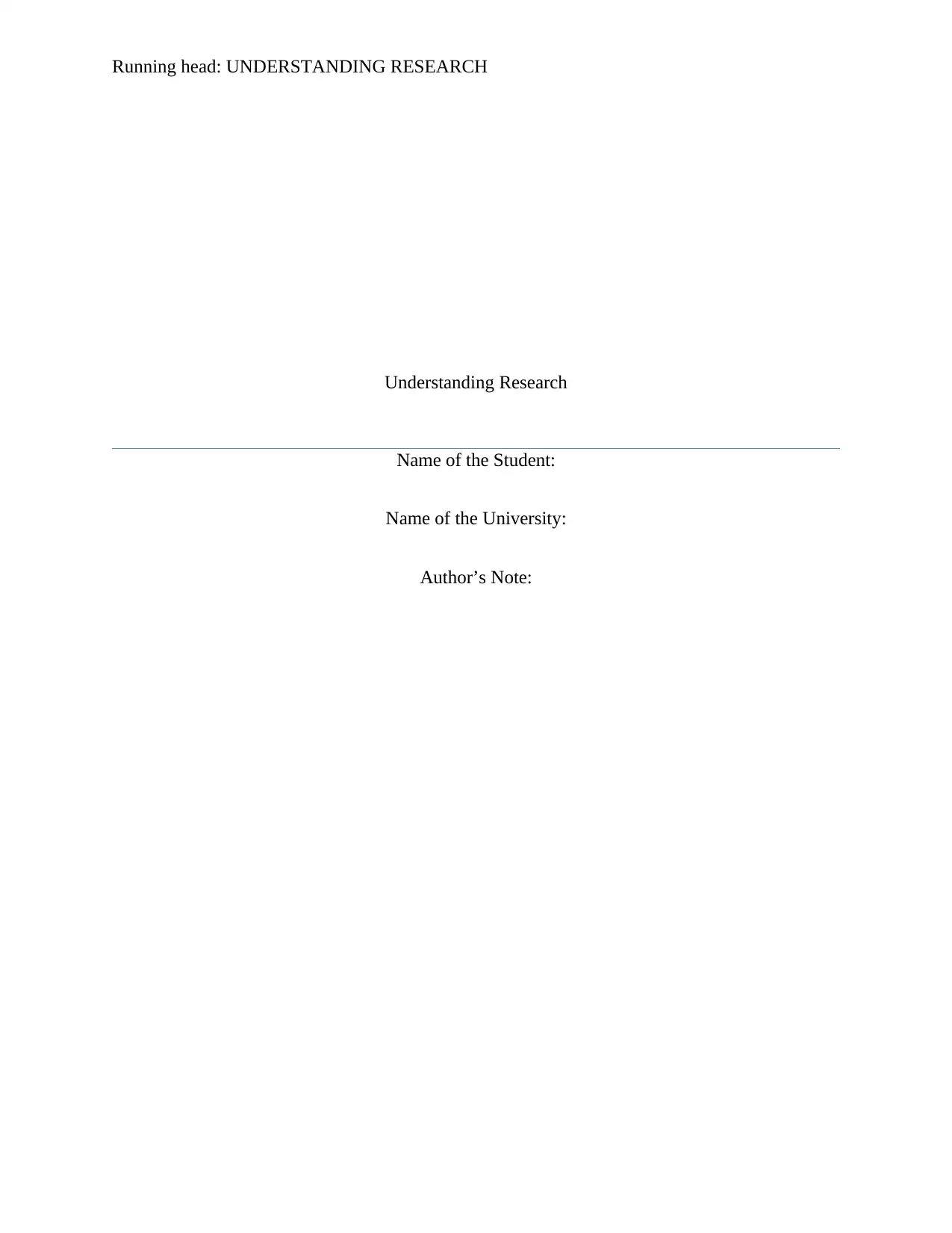
Running head: UNDERSTANDING RESEARCH
Understanding Research
Name of the Student:
Name of the University:
Author’s Note:
Understanding Research
Name of the Student:
Name of the University:
Author’s Note:
Paraphrase This Document
Need a fresh take? Get an instant paraphrase of this document with our AI Paraphraser
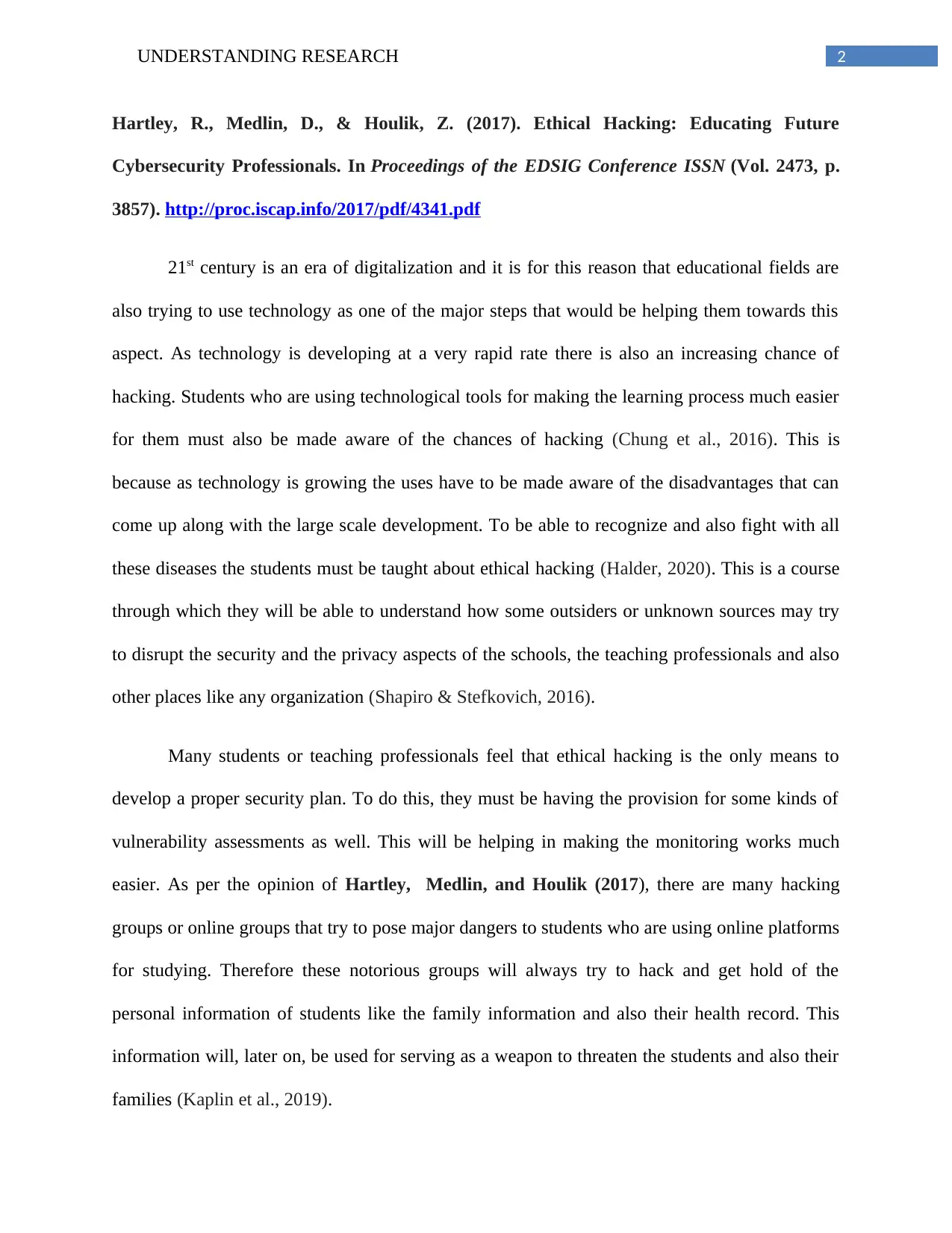
2UNDERSTANDING RESEARCH
Hartley, R., Medlin, D., & Houlik, Z. (2017). Ethical Hacking: Educating Future
Cybersecurity Professionals. In Proceedings of the EDSIG Conference ISSN (Vol. 2473, p.
3857). http://proc.iscap.info/2017/pdf/4341.pdf
21st century is an era of digitalization and it is for this reason that educational fields are
also trying to use technology as one of the major steps that would be helping them towards this
aspect. As technology is developing at a very rapid rate there is also an increasing chance of
hacking. Students who are using technological tools for making the learning process much easier
for them must also be made aware of the chances of hacking (Chung et al., 2016). This is
because as technology is growing the uses have to be made aware of the disadvantages that can
come up along with the large scale development. To be able to recognize and also fight with all
these diseases the students must be taught about ethical hacking (Halder, 2020). This is a course
through which they will be able to understand how some outsiders or unknown sources may try
to disrupt the security and the privacy aspects of the schools, the teaching professionals and also
other places like any organization (Shapiro & Stefkovich, 2016).
Many students or teaching professionals feel that ethical hacking is the only means to
develop a proper security plan. To do this, they must be having the provision for some kinds of
vulnerability assessments as well. This will be helping in making the monitoring works much
easier. As per the opinion of Hartley, Medlin, and Houlik (2017), there are many hacking
groups or online groups that try to pose major dangers to students who are using online platforms
for studying. Therefore these notorious groups will always try to hack and get hold of the
personal information of students like the family information and also their health record. This
information will, later on, be used for serving as a weapon to threaten the students and also their
families (Kaplin et al., 2019).
Hartley, R., Medlin, D., & Houlik, Z. (2017). Ethical Hacking: Educating Future
Cybersecurity Professionals. In Proceedings of the EDSIG Conference ISSN (Vol. 2473, p.
3857). http://proc.iscap.info/2017/pdf/4341.pdf
21st century is an era of digitalization and it is for this reason that educational fields are
also trying to use technology as one of the major steps that would be helping them towards this
aspect. As technology is developing at a very rapid rate there is also an increasing chance of
hacking. Students who are using technological tools for making the learning process much easier
for them must also be made aware of the chances of hacking (Chung et al., 2016). This is
because as technology is growing the uses have to be made aware of the disadvantages that can
come up along with the large scale development. To be able to recognize and also fight with all
these diseases the students must be taught about ethical hacking (Halder, 2020). This is a course
through which they will be able to understand how some outsiders or unknown sources may try
to disrupt the security and the privacy aspects of the schools, the teaching professionals and also
other places like any organization (Shapiro & Stefkovich, 2016).
Many students or teaching professionals feel that ethical hacking is the only means to
develop a proper security plan. To do this, they must be having the provision for some kinds of
vulnerability assessments as well. This will be helping in making the monitoring works much
easier. As per the opinion of Hartley, Medlin, and Houlik (2017), there are many hacking
groups or online groups that try to pose major dangers to students who are using online platforms
for studying. Therefore these notorious groups will always try to hack and get hold of the
personal information of students like the family information and also their health record. This
information will, later on, be used for serving as a weapon to threaten the students and also their
families (Kaplin et al., 2019).
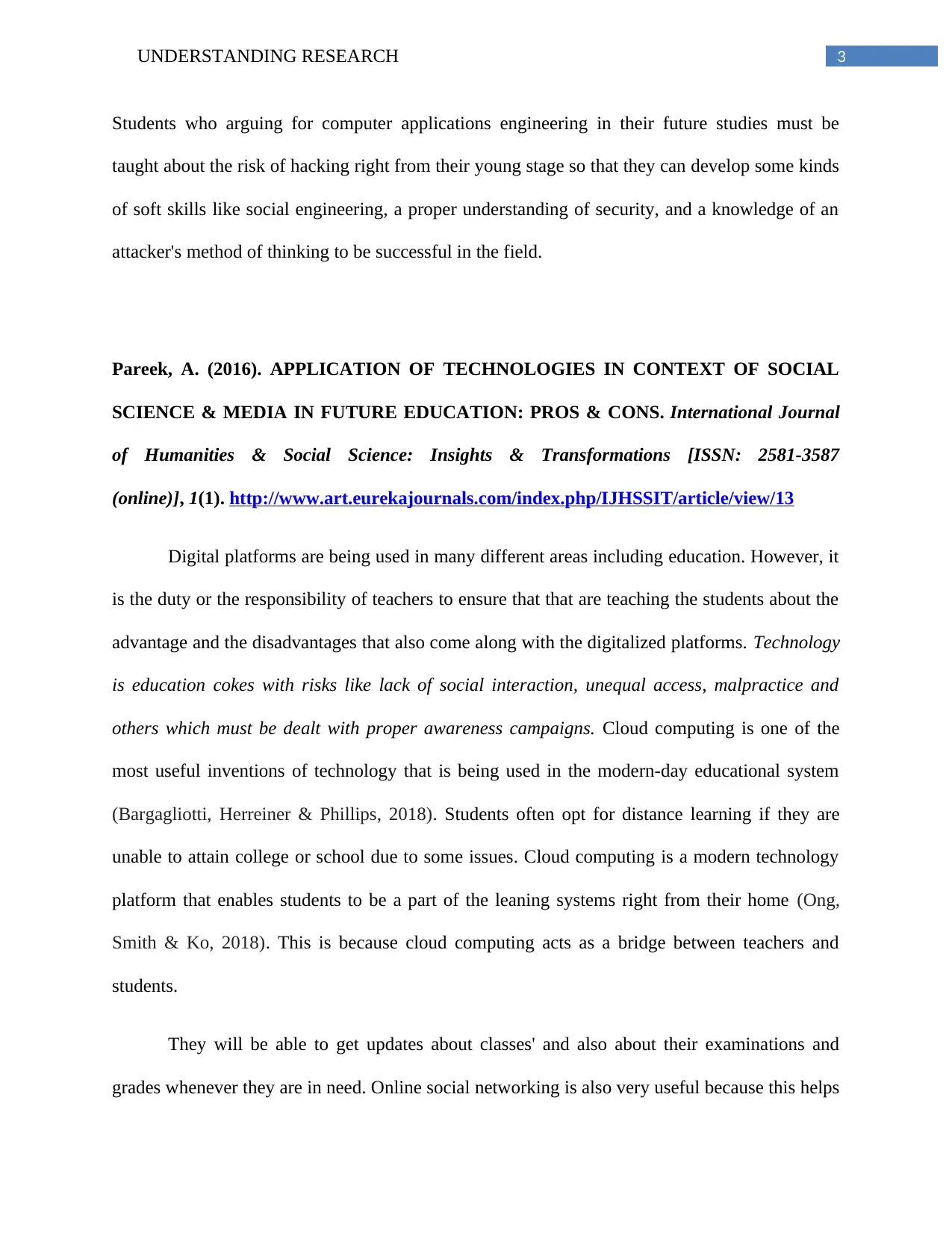
3UNDERSTANDING RESEARCH
Students who arguing for computer applications engineering in their future studies must be
taught about the risk of hacking right from their young stage so that they can develop some kinds
of soft skills like social engineering, a proper understanding of security, and a knowledge of an
attacker's method of thinking to be successful in the field.
Pareek, A. (2016). APPLICATION OF TECHNOLOGIES IN CONTEXT OF SOCIAL
SCIENCE & MEDIA IN FUTURE EDUCATION: PROS & CONS. International Journal
of Humanities & Social Science: Insights & Transformations [ISSN: 2581-3587
(online)], 1(1). http://www.art.eurekajournals.com/index.php/IJHSSIT/article/view/13
Digital platforms are being used in many different areas including education. However, it
is the duty or the responsibility of teachers to ensure that that are teaching the students about the
advantage and the disadvantages that also come along with the digitalized platforms. Technology
is education cokes with risks like lack of social interaction, unequal access, malpractice and
others which must be dealt with proper awareness campaigns. Cloud computing is one of the
most useful inventions of technology that is being used in the modern-day educational system
(Bargagliotti, Herreiner & Phillips, 2018). Students often opt for distance learning if they are
unable to attain college or school due to some issues. Cloud computing is a modern technology
platform that enables students to be a part of the leaning systems right from their home (Ong,
Smith & Ko, 2018). This is because cloud computing acts as a bridge between teachers and
students.
They will be able to get updates about classes' and also about their examinations and
grades whenever they are in need. Online social networking is also very useful because this helps
Students who arguing for computer applications engineering in their future studies must be
taught about the risk of hacking right from their young stage so that they can develop some kinds
of soft skills like social engineering, a proper understanding of security, and a knowledge of an
attacker's method of thinking to be successful in the field.
Pareek, A. (2016). APPLICATION OF TECHNOLOGIES IN CONTEXT OF SOCIAL
SCIENCE & MEDIA IN FUTURE EDUCATION: PROS & CONS. International Journal
of Humanities & Social Science: Insights & Transformations [ISSN: 2581-3587
(online)], 1(1). http://www.art.eurekajournals.com/index.php/IJHSSIT/article/view/13
Digital platforms are being used in many different areas including education. However, it
is the duty or the responsibility of teachers to ensure that that are teaching the students about the
advantage and the disadvantages that also come along with the digitalized platforms. Technology
is education cokes with risks like lack of social interaction, unequal access, malpractice and
others which must be dealt with proper awareness campaigns. Cloud computing is one of the
most useful inventions of technology that is being used in the modern-day educational system
(Bargagliotti, Herreiner & Phillips, 2018). Students often opt for distance learning if they are
unable to attain college or school due to some issues. Cloud computing is a modern technology
platform that enables students to be a part of the leaning systems right from their home (Ong,
Smith & Ko, 2018). This is because cloud computing acts as a bridge between teachers and
students.
They will be able to get updates about classes' and also about their examinations and
grades whenever they are in need. Online social networking is also very useful because this helps
⊘ This is a preview!⊘
Do you want full access?
Subscribe today to unlock all pages.

Trusted by 1+ million students worldwide
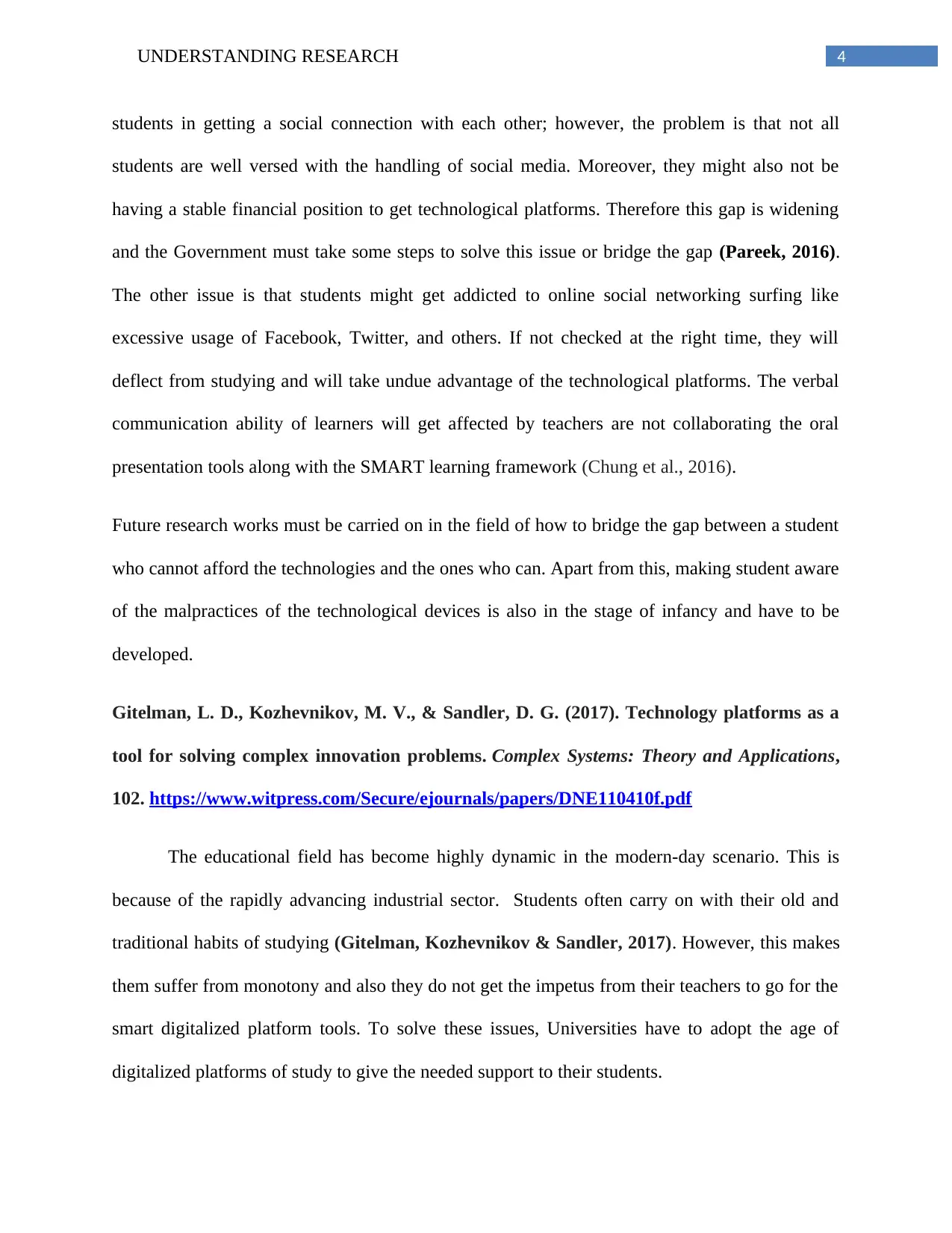
4UNDERSTANDING RESEARCH
students in getting a social connection with each other; however, the problem is that not all
students are well versed with the handling of social media. Moreover, they might also not be
having a stable financial position to get technological platforms. Therefore this gap is widening
and the Government must take some steps to solve this issue or bridge the gap (Pareek, 2016).
The other issue is that students might get addicted to online social networking surfing like
excessive usage of Facebook, Twitter, and others. If not checked at the right time, they will
deflect from studying and will take undue advantage of the technological platforms. The verbal
communication ability of learners will get affected by teachers are not collaborating the oral
presentation tools along with the SMART learning framework (Chung et al., 2016).
Future research works must be carried on in the field of how to bridge the gap between a student
who cannot afford the technologies and the ones who can. Apart from this, making student aware
of the malpractices of the technological devices is also in the stage of infancy and have to be
developed.
Gitelman, L. D., Kozhevnikov, M. V., & Sandler, D. G. (2017). Technology platforms as a
tool for solving complex innovation problems. Complex Systems: Theory and Applications,
102. https://www.witpress.com/Secure/ejournals/papers/DNE110410f.pdf
The educational field has become highly dynamic in the modern-day scenario. This is
because of the rapidly advancing industrial sector. Students often carry on with their old and
traditional habits of studying (Gitelman, Kozhevnikov & Sandler, 2017). However, this makes
them suffer from monotony and also they do not get the impetus from their teachers to go for the
smart digitalized platform tools. To solve these issues, Universities have to adopt the age of
digitalized platforms of study to give the needed support to their students.
students in getting a social connection with each other; however, the problem is that not all
students are well versed with the handling of social media. Moreover, they might also not be
having a stable financial position to get technological platforms. Therefore this gap is widening
and the Government must take some steps to solve this issue or bridge the gap (Pareek, 2016).
The other issue is that students might get addicted to online social networking surfing like
excessive usage of Facebook, Twitter, and others. If not checked at the right time, they will
deflect from studying and will take undue advantage of the technological platforms. The verbal
communication ability of learners will get affected by teachers are not collaborating the oral
presentation tools along with the SMART learning framework (Chung et al., 2016).
Future research works must be carried on in the field of how to bridge the gap between a student
who cannot afford the technologies and the ones who can. Apart from this, making student aware
of the malpractices of the technological devices is also in the stage of infancy and have to be
developed.
Gitelman, L. D., Kozhevnikov, M. V., & Sandler, D. G. (2017). Technology platforms as a
tool for solving complex innovation problems. Complex Systems: Theory and Applications,
102. https://www.witpress.com/Secure/ejournals/papers/DNE110410f.pdf
The educational field has become highly dynamic in the modern-day scenario. This is
because of the rapidly advancing industrial sector. Students often carry on with their old and
traditional habits of studying (Gitelman, Kozhevnikov & Sandler, 2017). However, this makes
them suffer from monotony and also they do not get the impetus from their teachers to go for the
smart digitalized platform tools. To solve these issues, Universities have to adopt the age of
digitalized platforms of study to give the needed support to their students.
Paraphrase This Document
Need a fresh take? Get an instant paraphrase of this document with our AI Paraphraser
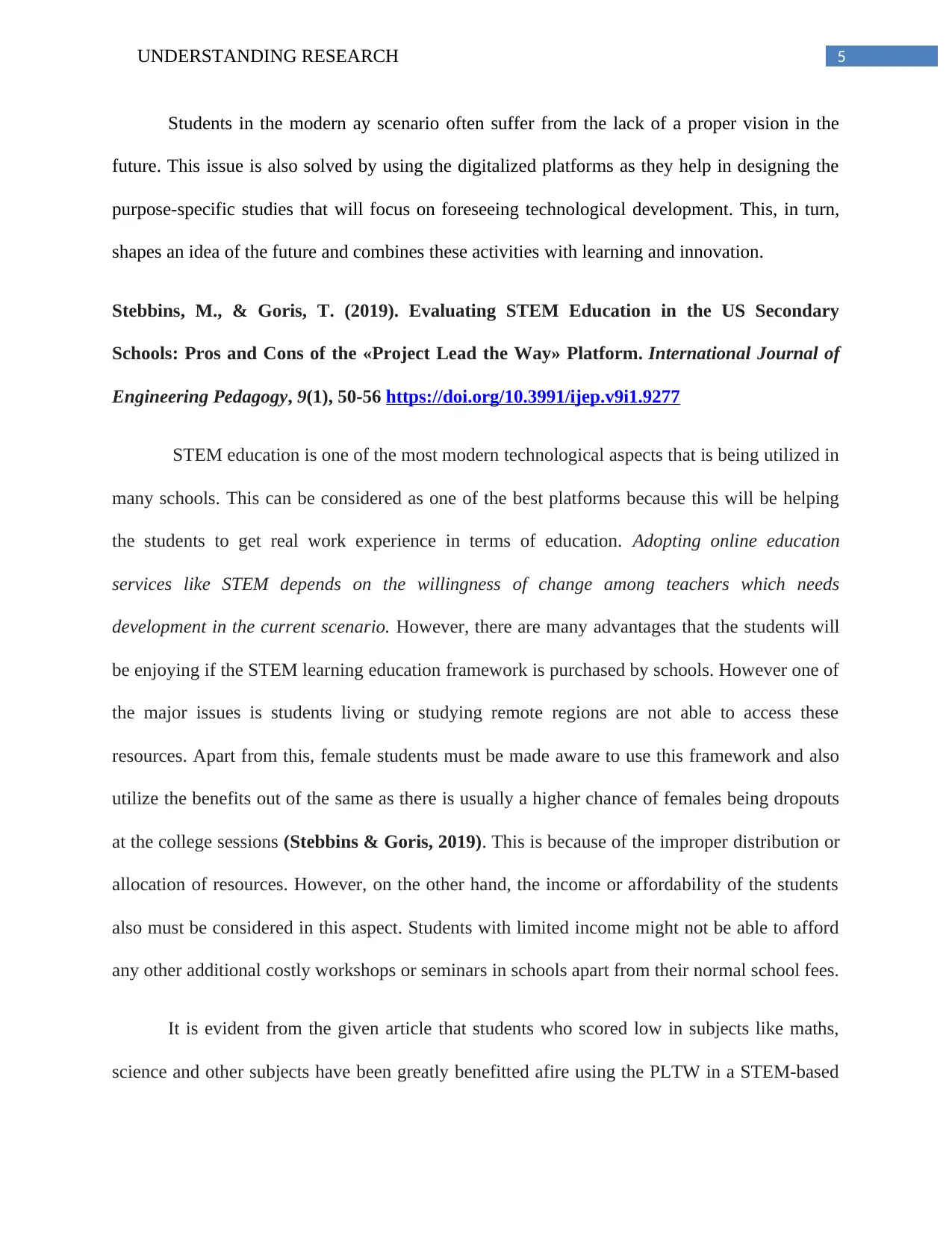
5UNDERSTANDING RESEARCH
Students in the modern ay scenario often suffer from the lack of a proper vision in the
future. This issue is also solved by using the digitalized platforms as they help in designing the
purpose-specific studies that will focus on foreseeing technological development. This, in turn,
shapes an idea of the future and combines these activities with learning and innovation.
Stebbins, M., & Goris, T. (2019). Evaluating STEM Education in the US Secondary
Schools: Pros and Cons of the «Project Lead the Way» Platform. International Journal of
Engineering Pedagogy, 9(1), 50-56 https://doi.org/10.3991/ijep.v9i1.9277
STEM education is one of the most modern technological aspects that is being utilized in
many schools. This can be considered as one of the best platforms because this will be helping
the students to get real work experience in terms of education. Adopting online education
services like STEM depends on the willingness of change among teachers which needs
development in the current scenario. However, there are many advantages that the students will
be enjoying if the STEM learning education framework is purchased by schools. However one of
the major issues is students living or studying remote regions are not able to access these
resources. Apart from this, female students must be made aware to use this framework and also
utilize the benefits out of the same as there is usually a higher chance of females being dropouts
at the college sessions (Stebbins & Goris, 2019). This is because of the improper distribution or
allocation of resources. However, on the other hand, the income or affordability of the students
also must be considered in this aspect. Students with limited income might not be able to afford
any other additional costly workshops or seminars in schools apart from their normal school fees.
It is evident from the given article that students who scored low in subjects like maths,
science and other subjects have been greatly benefitted afire using the PLTW in a STEM-based
Students in the modern ay scenario often suffer from the lack of a proper vision in the
future. This issue is also solved by using the digitalized platforms as they help in designing the
purpose-specific studies that will focus on foreseeing technological development. This, in turn,
shapes an idea of the future and combines these activities with learning and innovation.
Stebbins, M., & Goris, T. (2019). Evaluating STEM Education in the US Secondary
Schools: Pros and Cons of the «Project Lead the Way» Platform. International Journal of
Engineering Pedagogy, 9(1), 50-56 https://doi.org/10.3991/ijep.v9i1.9277
STEM education is one of the most modern technological aspects that is being utilized in
many schools. This can be considered as one of the best platforms because this will be helping
the students to get real work experience in terms of education. Adopting online education
services like STEM depends on the willingness of change among teachers which needs
development in the current scenario. However, there are many advantages that the students will
be enjoying if the STEM learning education framework is purchased by schools. However one of
the major issues is students living or studying remote regions are not able to access these
resources. Apart from this, female students must be made aware to use this framework and also
utilize the benefits out of the same as there is usually a higher chance of females being dropouts
at the college sessions (Stebbins & Goris, 2019). This is because of the improper distribution or
allocation of resources. However, on the other hand, the income or affordability of the students
also must be considered in this aspect. Students with limited income might not be able to afford
any other additional costly workshops or seminars in schools apart from their normal school fees.
It is evident from the given article that students who scored low in subjects like maths,
science and other subjects have been greatly benefitted afire using the PLTW in a STEM-based
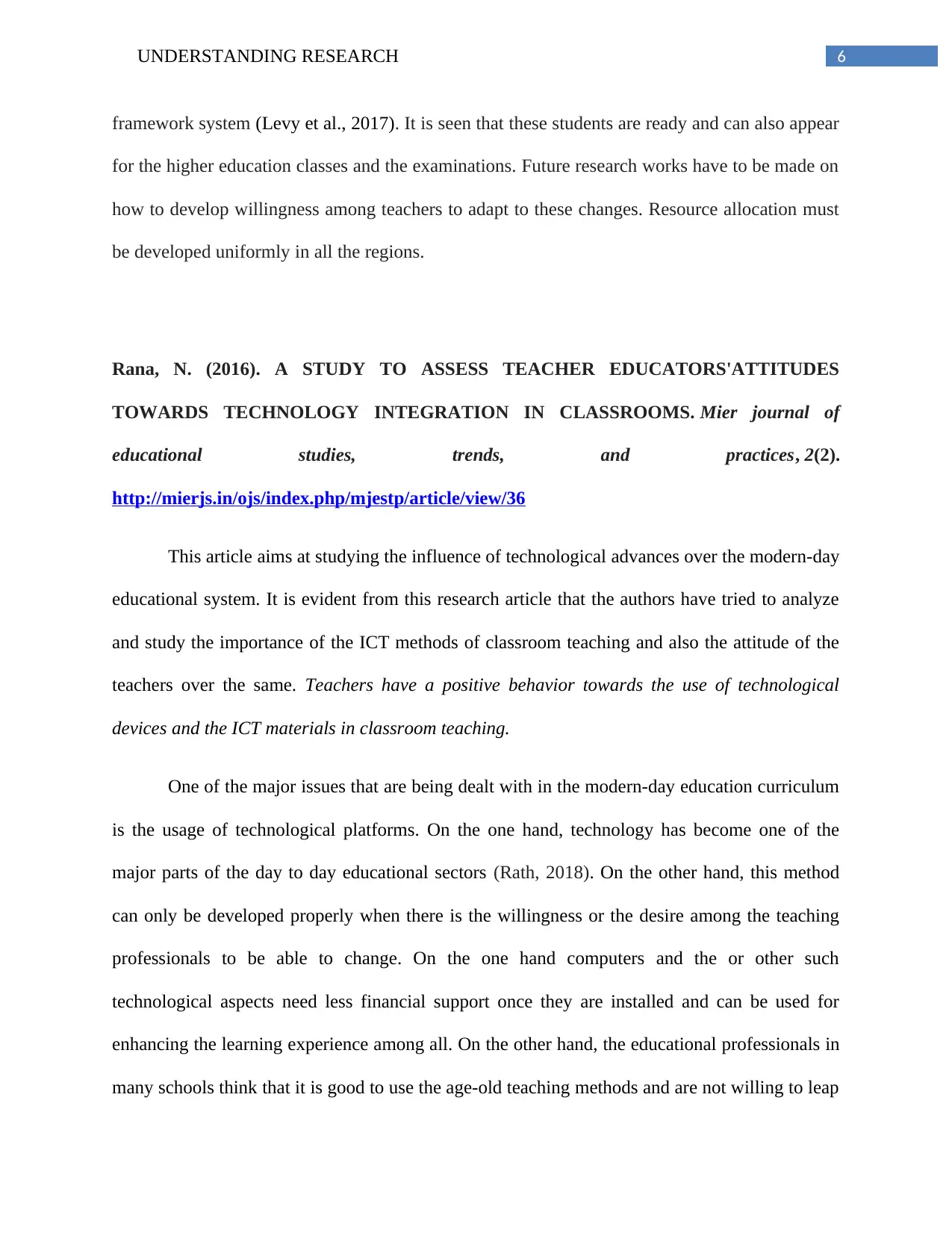
6UNDERSTANDING RESEARCH
framework system (Levy et al., 2017). It is seen that these students are ready and can also appear
for the higher education classes and the examinations. Future research works have to be made on
how to develop willingness among teachers to adapt to these changes. Resource allocation must
be developed uniformly in all the regions.
Rana, N. (2016). A STUDY TO ASSESS TEACHER EDUCATORS'ATTITUDES
TOWARDS TECHNOLOGY INTEGRATION IN CLASSROOMS. Mier journal of
educational studies, trends, and practices, 2(2).
http://mierjs.in/ojs/index.php/mjestp/article/view/36
This article aims at studying the influence of technological advances over the modern-day
educational system. It is evident from this research article that the authors have tried to analyze
and study the importance of the ICT methods of classroom teaching and also the attitude of the
teachers over the same. Teachers have a positive behavior towards the use of technological
devices and the ICT materials in classroom teaching.
One of the major issues that are being dealt with in the modern-day education curriculum
is the usage of technological platforms. On the one hand, technology has become one of the
major parts of the day to day educational sectors (Rath, 2018). On the other hand, this method
can only be developed properly when there is the willingness or the desire among the teaching
professionals to be able to change. On the one hand computers and the or other such
technological aspects need less financial support once they are installed and can be used for
enhancing the learning experience among all. On the other hand, the educational professionals in
many schools think that it is good to use the age-old teaching methods and are not willing to leap
framework system (Levy et al., 2017). It is seen that these students are ready and can also appear
for the higher education classes and the examinations. Future research works have to be made on
how to develop willingness among teachers to adapt to these changes. Resource allocation must
be developed uniformly in all the regions.
Rana, N. (2016). A STUDY TO ASSESS TEACHER EDUCATORS'ATTITUDES
TOWARDS TECHNOLOGY INTEGRATION IN CLASSROOMS. Mier journal of
educational studies, trends, and practices, 2(2).
http://mierjs.in/ojs/index.php/mjestp/article/view/36
This article aims at studying the influence of technological advances over the modern-day
educational system. It is evident from this research article that the authors have tried to analyze
and study the importance of the ICT methods of classroom teaching and also the attitude of the
teachers over the same. Teachers have a positive behavior towards the use of technological
devices and the ICT materials in classroom teaching.
One of the major issues that are being dealt with in the modern-day education curriculum
is the usage of technological platforms. On the one hand, technology has become one of the
major parts of the day to day educational sectors (Rath, 2018). On the other hand, this method
can only be developed properly when there is the willingness or the desire among the teaching
professionals to be able to change. On the one hand computers and the or other such
technological aspects need less financial support once they are installed and can be used for
enhancing the learning experience among all. On the other hand, the educational professionals in
many schools think that it is good to use the age-old teaching methods and are not willing to leap
⊘ This is a preview!⊘
Do you want full access?
Subscribe today to unlock all pages.

Trusted by 1+ million students worldwide
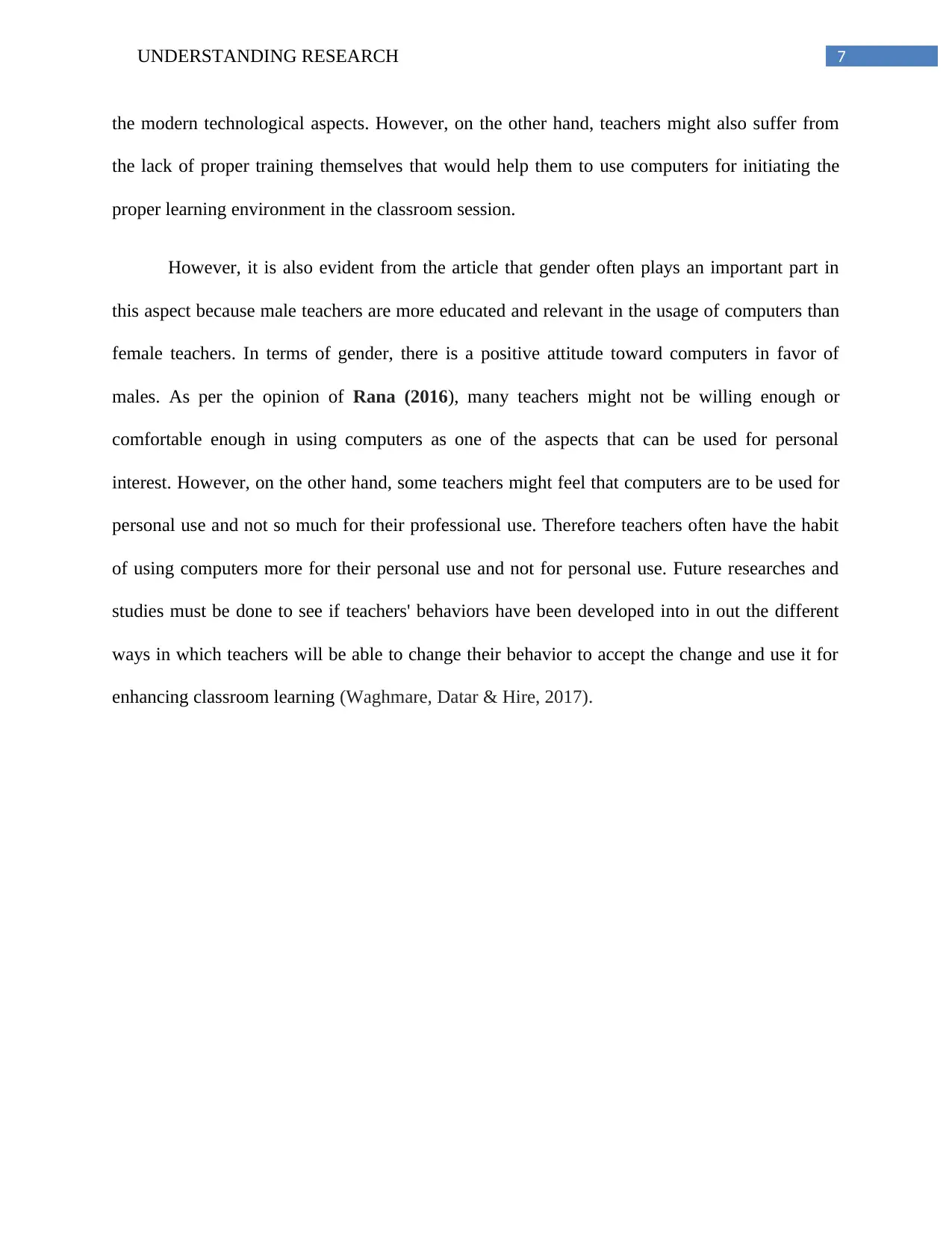
7UNDERSTANDING RESEARCH
the modern technological aspects. However, on the other hand, teachers might also suffer from
the lack of proper training themselves that would help them to use computers for initiating the
proper learning environment in the classroom session.
However, it is also evident from the article that gender often plays an important part in
this aspect because male teachers are more educated and relevant in the usage of computers than
female teachers. In terms of gender, there is a positive attitude toward computers in favor of
males. As per the opinion of Rana (2016), many teachers might not be willing enough or
comfortable enough in using computers as one of the aspects that can be used for personal
interest. However, on the other hand, some teachers might feel that computers are to be used for
personal use and not so much for their professional use. Therefore teachers often have the habit
of using computers more for their personal use and not for personal use. Future researches and
studies must be done to see if teachers' behaviors have been developed into in out the different
ways in which teachers will be able to change their behavior to accept the change and use it for
enhancing classroom learning (Waghmare, Datar & Hire, 2017).
the modern technological aspects. However, on the other hand, teachers might also suffer from
the lack of proper training themselves that would help them to use computers for initiating the
proper learning environment in the classroom session.
However, it is also evident from the article that gender often plays an important part in
this aspect because male teachers are more educated and relevant in the usage of computers than
female teachers. In terms of gender, there is a positive attitude toward computers in favor of
males. As per the opinion of Rana (2016), many teachers might not be willing enough or
comfortable enough in using computers as one of the aspects that can be used for personal
interest. However, on the other hand, some teachers might feel that computers are to be used for
personal use and not so much for their professional use. Therefore teachers often have the habit
of using computers more for their personal use and not for personal use. Future researches and
studies must be done to see if teachers' behaviors have been developed into in out the different
ways in which teachers will be able to change their behavior to accept the change and use it for
enhancing classroom learning (Waghmare, Datar & Hire, 2017).
Paraphrase This Document
Need a fresh take? Get an instant paraphrase of this document with our AI Paraphraser
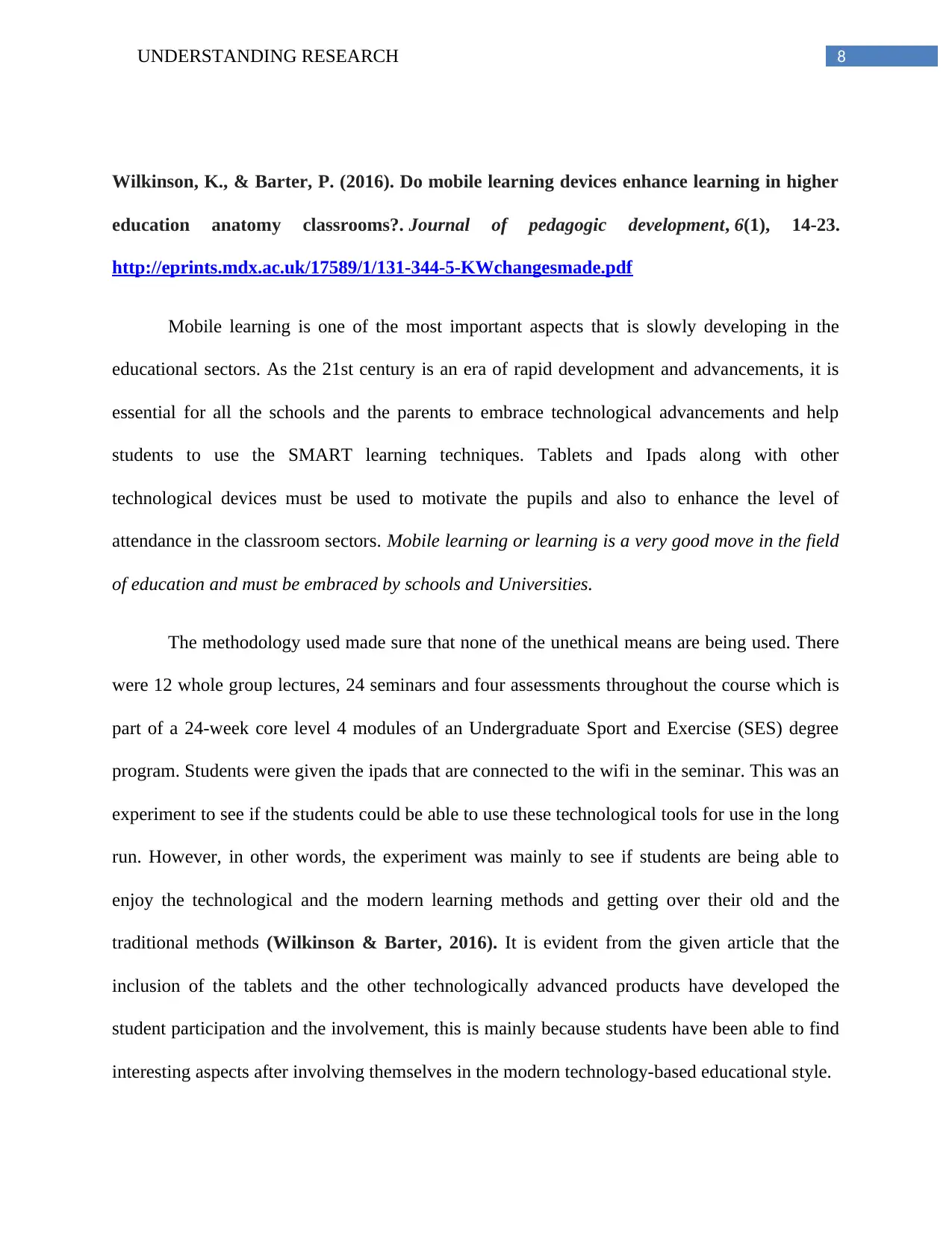
8UNDERSTANDING RESEARCH
Wilkinson, K., & Barter, P. (2016). Do mobile learning devices enhance learning in higher
education anatomy classrooms?. Journal of pedagogic development, 6(1), 14-23.
http://eprints.mdx.ac.uk/17589/1/131-344-5-KWchangesmade.pdf
Mobile learning is one of the most important aspects that is slowly developing in the
educational sectors. As the 21st century is an era of rapid development and advancements, it is
essential for all the schools and the parents to embrace technological advancements and help
students to use the SMART learning techniques. Tablets and Ipads along with other
technological devices must be used to motivate the pupils and also to enhance the level of
attendance in the classroom sectors. Mobile learning or learning is a very good move in the field
of education and must be embraced by schools and Universities.
The methodology used made sure that none of the unethical means are being used. There
were 12 whole group lectures, 24 seminars and four assessments throughout the course which is
part of a 24-week core level 4 modules of an Undergraduate Sport and Exercise (SES) degree
program. Students were given the ipads that are connected to the wifi in the seminar. This was an
experiment to see if the students could be able to use these technological tools for use in the long
run. However, in other words, the experiment was mainly to see if students are being able to
enjoy the technological and the modern learning methods and getting over their old and the
traditional methods (Wilkinson & Barter, 2016). It is evident from the given article that the
inclusion of the tablets and the other technologically advanced products have developed the
student participation and the involvement, this is mainly because students have been able to find
interesting aspects after involving themselves in the modern technology-based educational style.
Wilkinson, K., & Barter, P. (2016). Do mobile learning devices enhance learning in higher
education anatomy classrooms?. Journal of pedagogic development, 6(1), 14-23.
http://eprints.mdx.ac.uk/17589/1/131-344-5-KWchangesmade.pdf
Mobile learning is one of the most important aspects that is slowly developing in the
educational sectors. As the 21st century is an era of rapid development and advancements, it is
essential for all the schools and the parents to embrace technological advancements and help
students to use the SMART learning techniques. Tablets and Ipads along with other
technological devices must be used to motivate the pupils and also to enhance the level of
attendance in the classroom sectors. Mobile learning or learning is a very good move in the field
of education and must be embraced by schools and Universities.
The methodology used made sure that none of the unethical means are being used. There
were 12 whole group lectures, 24 seminars and four assessments throughout the course which is
part of a 24-week core level 4 modules of an Undergraduate Sport and Exercise (SES) degree
program. Students were given the ipads that are connected to the wifi in the seminar. This was an
experiment to see if the students could be able to use these technological tools for use in the long
run. However, in other words, the experiment was mainly to see if students are being able to
enjoy the technological and the modern learning methods and getting over their old and the
traditional methods (Wilkinson & Barter, 2016). It is evident from the given article that the
inclusion of the tablets and the other technologically advanced products have developed the
student participation and the involvement, this is mainly because students have been able to find
interesting aspects after involving themselves in the modern technology-based educational style.
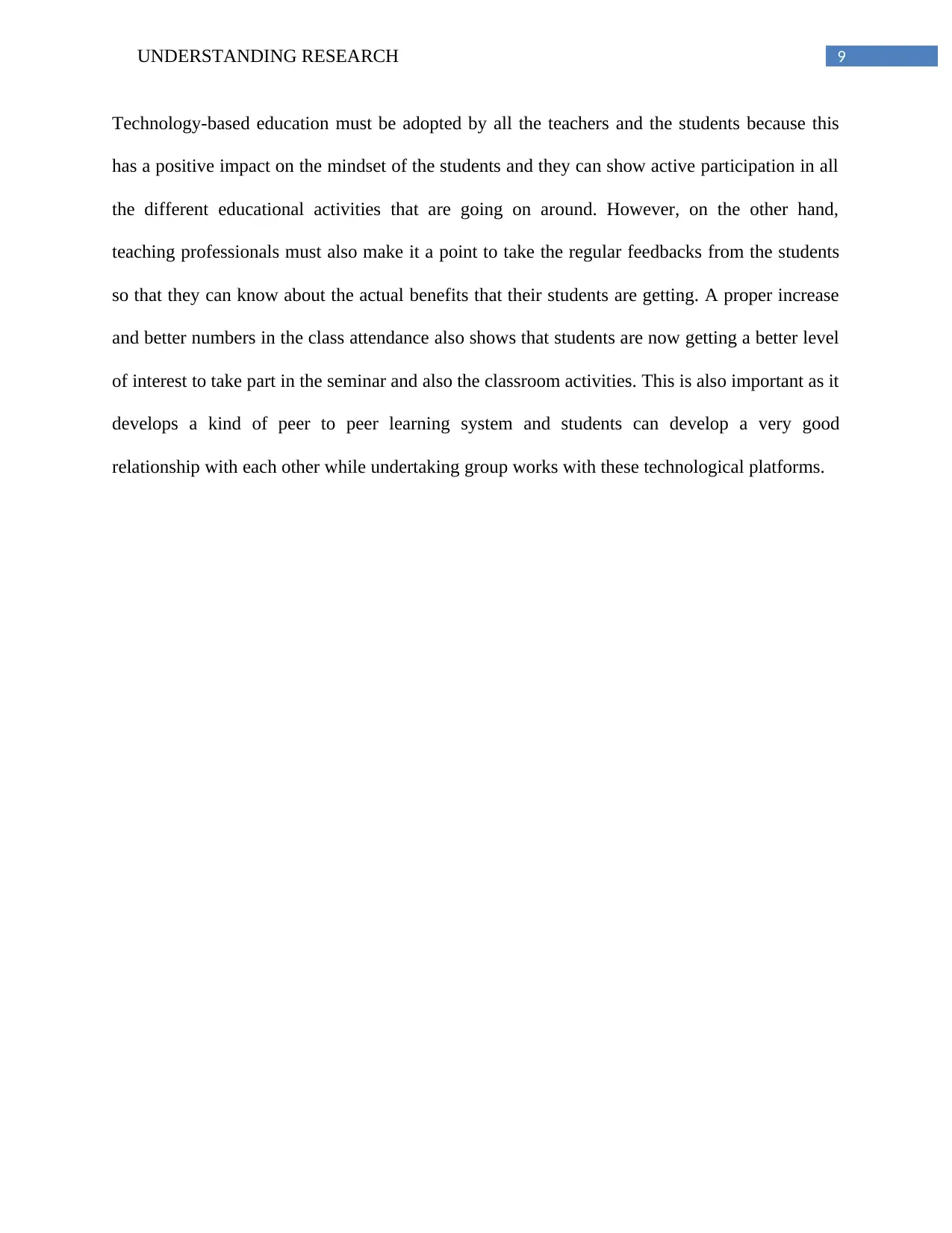
9UNDERSTANDING RESEARCH
Technology-based education must be adopted by all the teachers and the students because this
has a positive impact on the mindset of the students and they can show active participation in all
the different educational activities that are going on around. However, on the other hand,
teaching professionals must also make it a point to take the regular feedbacks from the students
so that they can know about the actual benefits that their students are getting. A proper increase
and better numbers in the class attendance also shows that students are now getting a better level
of interest to take part in the seminar and also the classroom activities. This is also important as it
develops a kind of peer to peer learning system and students can develop a very good
relationship with each other while undertaking group works with these technological platforms.
Technology-based education must be adopted by all the teachers and the students because this
has a positive impact on the mindset of the students and they can show active participation in all
the different educational activities that are going on around. However, on the other hand,
teaching professionals must also make it a point to take the regular feedbacks from the students
so that they can know about the actual benefits that their students are getting. A proper increase
and better numbers in the class attendance also shows that students are now getting a better level
of interest to take part in the seminar and also the classroom activities. This is also important as it
develops a kind of peer to peer learning system and students can develop a very good
relationship with each other while undertaking group works with these technological platforms.
⊘ This is a preview!⊘
Do you want full access?
Subscribe today to unlock all pages.

Trusted by 1+ million students worldwide
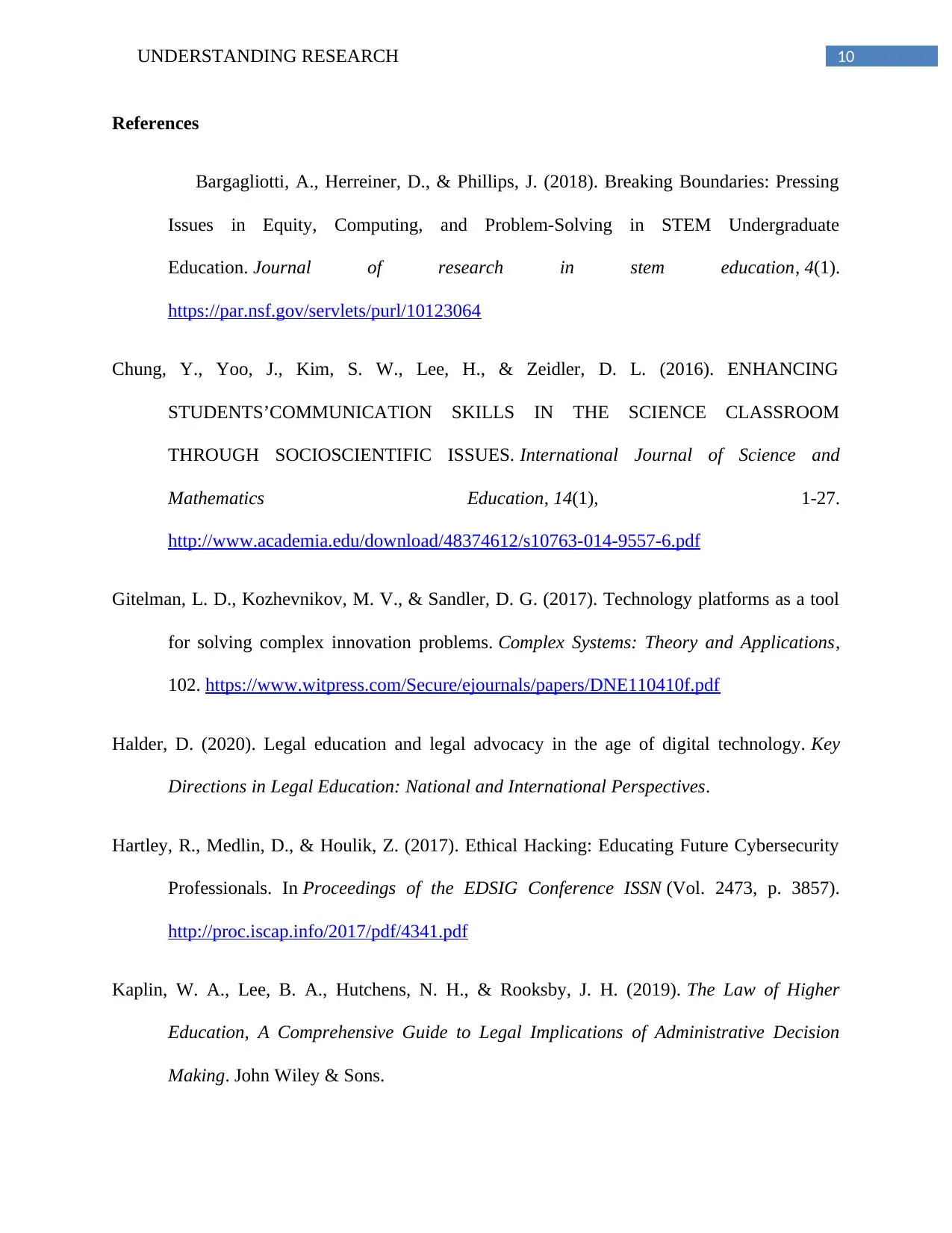
10UNDERSTANDING RESEARCH
References
Bargagliotti, A., Herreiner, D., & Phillips, J. (2018). Breaking Boundaries: Pressing
Issues in Equity, Computing, and Problem-Solving in STEM Undergraduate
Education. Journal of research in stem education, 4(1).
https://par.nsf.gov/servlets/purl/10123064
Chung, Y., Yoo, J., Kim, S. W., Lee, H., & Zeidler, D. L. (2016). ENHANCING
STUDENTS’COMMUNICATION SKILLS IN THE SCIENCE CLASSROOM
THROUGH SOCIOSCIENTIFIC ISSUES. International Journal of Science and
Mathematics Education, 14(1), 1-27.
http://www.academia.edu/download/48374612/s10763-014-9557-6.pdf
Gitelman, L. D., Kozhevnikov, M. V., & Sandler, D. G. (2017). Technology platforms as a tool
for solving complex innovation problems. Complex Systems: Theory and Applications,
102. https://www.witpress.com/Secure/ejournals/papers/DNE110410f.pdf
Halder, D. (2020). Legal education and legal advocacy in the age of digital technology. Key
Directions in Legal Education: National and International Perspectives.
Hartley, R., Medlin, D., & Houlik, Z. (2017). Ethical Hacking: Educating Future Cybersecurity
Professionals. In Proceedings of the EDSIG Conference ISSN (Vol. 2473, p. 3857).
http://proc.iscap.info/2017/pdf/4341.pdf
Kaplin, W. A., Lee, B. A., Hutchens, N. H., & Rooksby, J. H. (2019). The Law of Higher
Education, A Comprehensive Guide to Legal Implications of Administrative Decision
Making. John Wiley & Sons.
References
Bargagliotti, A., Herreiner, D., & Phillips, J. (2018). Breaking Boundaries: Pressing
Issues in Equity, Computing, and Problem-Solving in STEM Undergraduate
Education. Journal of research in stem education, 4(1).
https://par.nsf.gov/servlets/purl/10123064
Chung, Y., Yoo, J., Kim, S. W., Lee, H., & Zeidler, D. L. (2016). ENHANCING
STUDENTS’COMMUNICATION SKILLS IN THE SCIENCE CLASSROOM
THROUGH SOCIOSCIENTIFIC ISSUES. International Journal of Science and
Mathematics Education, 14(1), 1-27.
http://www.academia.edu/download/48374612/s10763-014-9557-6.pdf
Gitelman, L. D., Kozhevnikov, M. V., & Sandler, D. G. (2017). Technology platforms as a tool
for solving complex innovation problems. Complex Systems: Theory and Applications,
102. https://www.witpress.com/Secure/ejournals/papers/DNE110410f.pdf
Halder, D. (2020). Legal education and legal advocacy in the age of digital technology. Key
Directions in Legal Education: National and International Perspectives.
Hartley, R., Medlin, D., & Houlik, Z. (2017). Ethical Hacking: Educating Future Cybersecurity
Professionals. In Proceedings of the EDSIG Conference ISSN (Vol. 2473, p. 3857).
http://proc.iscap.info/2017/pdf/4341.pdf
Kaplin, W. A., Lee, B. A., Hutchens, N. H., & Rooksby, J. H. (2019). The Law of Higher
Education, A Comprehensive Guide to Legal Implications of Administrative Decision
Making. John Wiley & Sons.
Paraphrase This Document
Need a fresh take? Get an instant paraphrase of this document with our AI Paraphraser
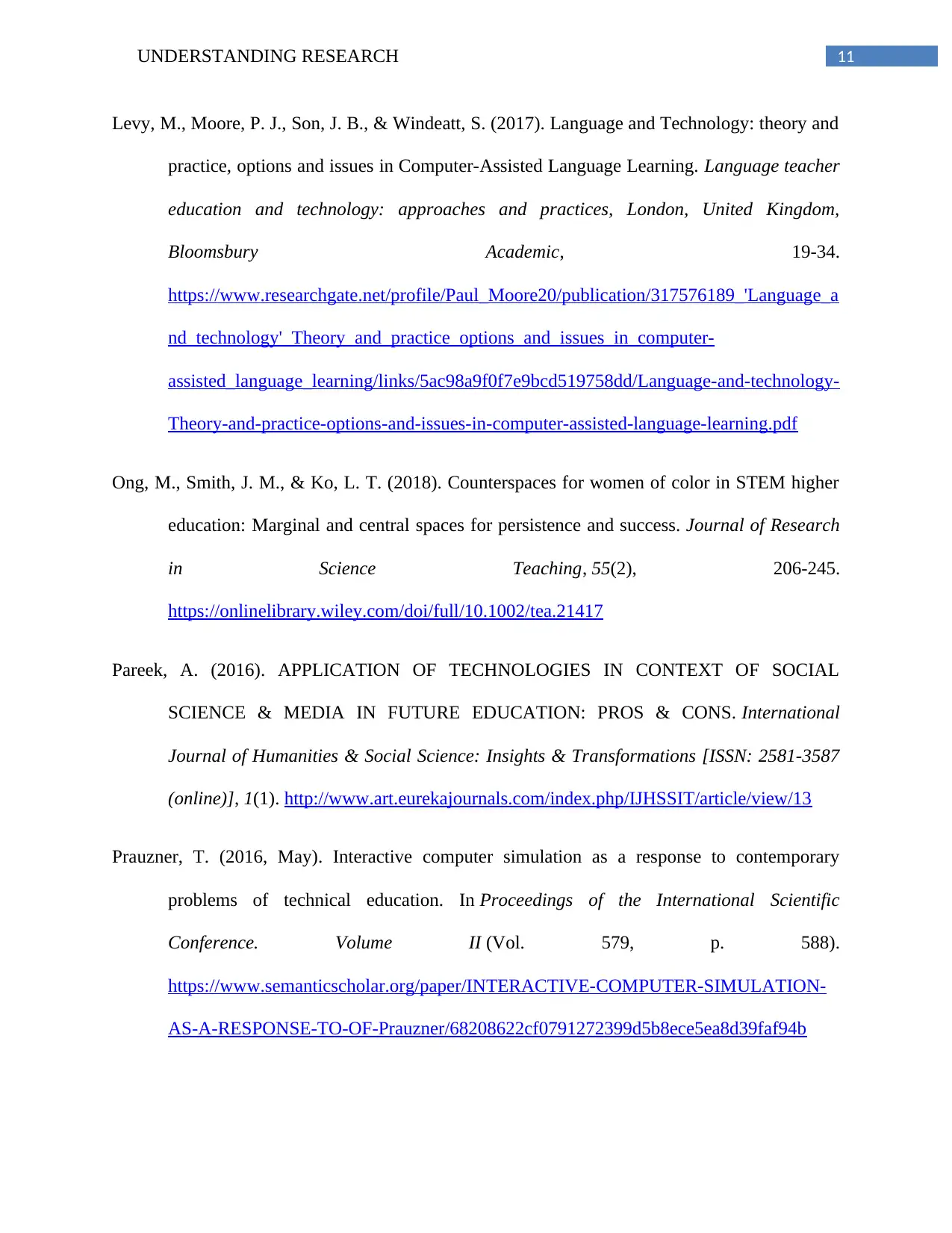
11UNDERSTANDING RESEARCH
Levy, M., Moore, P. J., Son, J. B., & Windeatt, S. (2017). Language and Technology: theory and
practice, options and issues in Computer-Assisted Language Learning. Language teacher
education and technology: approaches and practices, London, United Kingdom,
Bloomsbury Academic, 19-34.
https://www.researchgate.net/profile/Paul_Moore20/publication/317576189_'Language_a
nd_technology'_Theory_and_practice_options_and_issues_in_computer-
assisted_language_learning/links/5ac98a9f0f7e9bcd519758dd/Language-and-technology-
Theory-and-practice-options-and-issues-in-computer-assisted-language-learning.pdf
Ong, M., Smith, J. M., & Ko, L. T. (2018). Counterspaces for women of color in STEM higher
education: Marginal and central spaces for persistence and success. Journal of Research
in Science Teaching, 55(2), 206-245.
https://onlinelibrary.wiley.com/doi/full/10.1002/tea.21417
Pareek, A. (2016). APPLICATION OF TECHNOLOGIES IN CONTEXT OF SOCIAL
SCIENCE & MEDIA IN FUTURE EDUCATION: PROS & CONS. International
Journal of Humanities & Social Science: Insights & Transformations [ISSN: 2581-3587
(online)], 1(1). http://www.art.eurekajournals.com/index.php/IJHSSIT/article/view/13
Prauzner, T. (2016, May). Interactive computer simulation as a response to contemporary
problems of technical education. In Proceedings of the International Scientific
Conference. Volume II (Vol. 579, p. 588).
https://www.semanticscholar.org/paper/INTERACTIVE-COMPUTER-SIMULATION-
AS-A-RESPONSE-TO-OF-Prauzner/68208622cf0791272399d5b8ece5ea8d39faf94b
Levy, M., Moore, P. J., Son, J. B., & Windeatt, S. (2017). Language and Technology: theory and
practice, options and issues in Computer-Assisted Language Learning. Language teacher
education and technology: approaches and practices, London, United Kingdom,
Bloomsbury Academic, 19-34.
https://www.researchgate.net/profile/Paul_Moore20/publication/317576189_'Language_a
nd_technology'_Theory_and_practice_options_and_issues_in_computer-
assisted_language_learning/links/5ac98a9f0f7e9bcd519758dd/Language-and-technology-
Theory-and-practice-options-and-issues-in-computer-assisted-language-learning.pdf
Ong, M., Smith, J. M., & Ko, L. T. (2018). Counterspaces for women of color in STEM higher
education: Marginal and central spaces for persistence and success. Journal of Research
in Science Teaching, 55(2), 206-245.
https://onlinelibrary.wiley.com/doi/full/10.1002/tea.21417
Pareek, A. (2016). APPLICATION OF TECHNOLOGIES IN CONTEXT OF SOCIAL
SCIENCE & MEDIA IN FUTURE EDUCATION: PROS & CONS. International
Journal of Humanities & Social Science: Insights & Transformations [ISSN: 2581-3587
(online)], 1(1). http://www.art.eurekajournals.com/index.php/IJHSSIT/article/view/13
Prauzner, T. (2016, May). Interactive computer simulation as a response to contemporary
problems of technical education. In Proceedings of the International Scientific
Conference. Volume II (Vol. 579, p. 588).
https://www.semanticscholar.org/paper/INTERACTIVE-COMPUTER-SIMULATION-
AS-A-RESPONSE-TO-OF-Prauzner/68208622cf0791272399d5b8ece5ea8d39faf94b
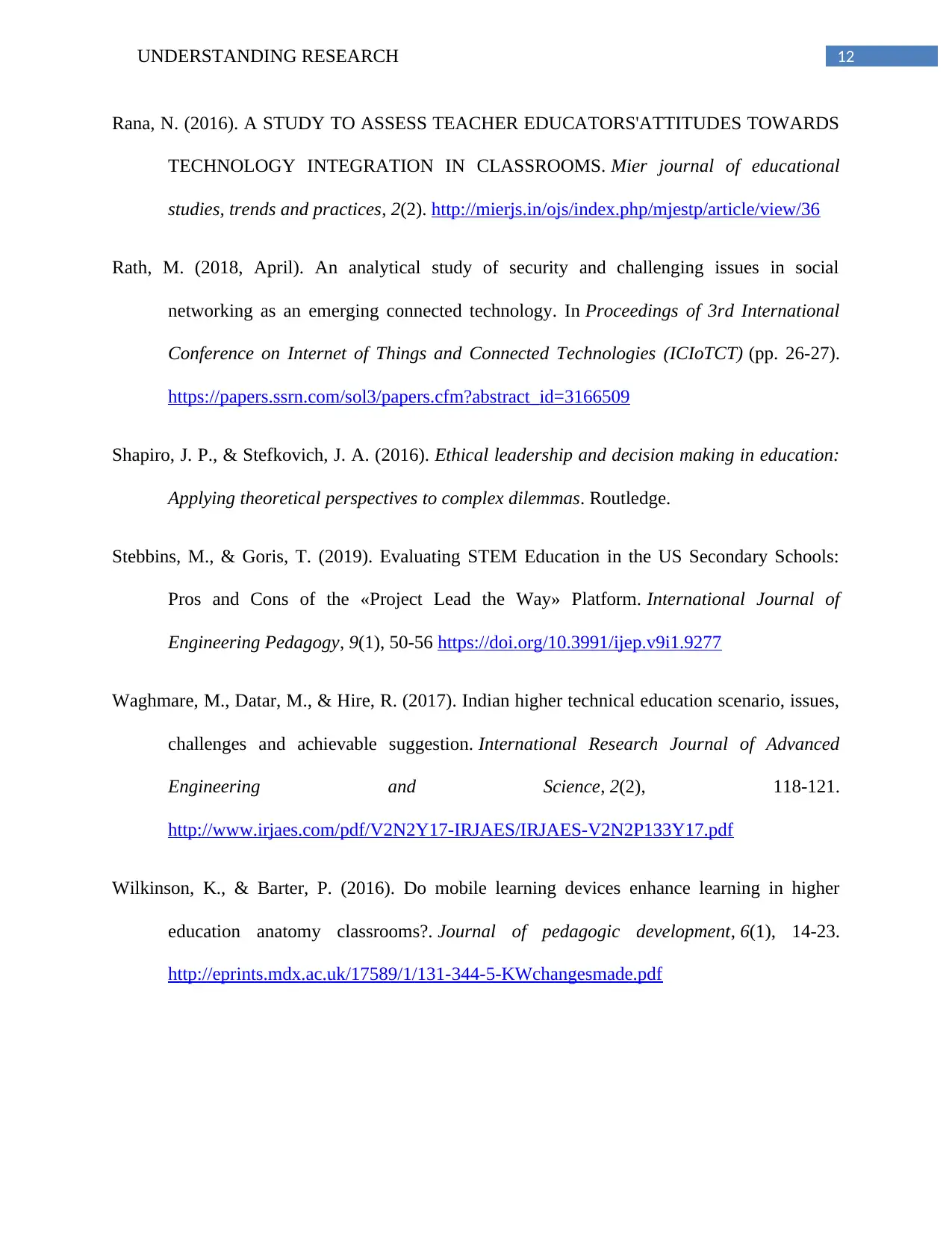
12UNDERSTANDING RESEARCH
Rana, N. (2016). A STUDY TO ASSESS TEACHER EDUCATORS'ATTITUDES TOWARDS
TECHNOLOGY INTEGRATION IN CLASSROOMS. Mier journal of educational
studies, trends and practices, 2(2). http://mierjs.in/ojs/index.php/mjestp/article/view/36
Rath, M. (2018, April). An analytical study of security and challenging issues in social
networking as an emerging connected technology. In Proceedings of 3rd International
Conference on Internet of Things and Connected Technologies (ICIoTCT) (pp. 26-27).
https://papers.ssrn.com/sol3/papers.cfm?abstract_id=3166509
Shapiro, J. P., & Stefkovich, J. A. (2016). Ethical leadership and decision making in education:
Applying theoretical perspectives to complex dilemmas. Routledge.
Stebbins, M., & Goris, T. (2019). Evaluating STEM Education in the US Secondary Schools:
Pros and Cons of the «Project Lead the Way» Platform. International Journal of
Engineering Pedagogy, 9(1), 50-56 https://doi.org/10.3991/ijep.v9i1.9277
Waghmare, M., Datar, M., & Hire, R. (2017). Indian higher technical education scenario, issues,
challenges and achievable suggestion. International Research Journal of Advanced
Engineering and Science, 2(2), 118-121.
http://www.irjaes.com/pdf/V2N2Y17-IRJAES/IRJAES-V2N2P133Y17.pdf
Wilkinson, K., & Barter, P. (2016). Do mobile learning devices enhance learning in higher
education anatomy classrooms?. Journal of pedagogic development, 6(1), 14-23.
http://eprints.mdx.ac.uk/17589/1/131-344-5-KWchangesmade.pdf
Rana, N. (2016). A STUDY TO ASSESS TEACHER EDUCATORS'ATTITUDES TOWARDS
TECHNOLOGY INTEGRATION IN CLASSROOMS. Mier journal of educational
studies, trends and practices, 2(2). http://mierjs.in/ojs/index.php/mjestp/article/view/36
Rath, M. (2018, April). An analytical study of security and challenging issues in social
networking as an emerging connected technology. In Proceedings of 3rd International
Conference on Internet of Things and Connected Technologies (ICIoTCT) (pp. 26-27).
https://papers.ssrn.com/sol3/papers.cfm?abstract_id=3166509
Shapiro, J. P., & Stefkovich, J. A. (2016). Ethical leadership and decision making in education:
Applying theoretical perspectives to complex dilemmas. Routledge.
Stebbins, M., & Goris, T. (2019). Evaluating STEM Education in the US Secondary Schools:
Pros and Cons of the «Project Lead the Way» Platform. International Journal of
Engineering Pedagogy, 9(1), 50-56 https://doi.org/10.3991/ijep.v9i1.9277
Waghmare, M., Datar, M., & Hire, R. (2017). Indian higher technical education scenario, issues,
challenges and achievable suggestion. International Research Journal of Advanced
Engineering and Science, 2(2), 118-121.
http://www.irjaes.com/pdf/V2N2Y17-IRJAES/IRJAES-V2N2P133Y17.pdf
Wilkinson, K., & Barter, P. (2016). Do mobile learning devices enhance learning in higher
education anatomy classrooms?. Journal of pedagogic development, 6(1), 14-23.
http://eprints.mdx.ac.uk/17589/1/131-344-5-KWchangesmade.pdf
⊘ This is a preview!⊘
Do you want full access?
Subscribe today to unlock all pages.

Trusted by 1+ million students worldwide
1 out of 13
Related Documents
Your All-in-One AI-Powered Toolkit for Academic Success.
+13062052269
info@desklib.com
Available 24*7 on WhatsApp / Email
![[object Object]](/_next/static/media/star-bottom.7253800d.svg)
Unlock your academic potential
Copyright © 2020–2025 A2Z Services. All Rights Reserved. Developed and managed by ZUCOL.





